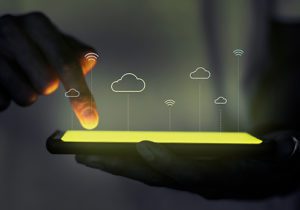July 19th, 2021
Category: Economics,International
No Comments
Posted by: Team TA

Move over, 4G- 5G is here! In the race to replace the future, the next-generation wireless technology has hit the mainstream. 5G technology is all set to change your life with enhanced connectivity, revolutionary speed, superior reliability, and responsiveness. This disruptive technology boasts to offer speed surging past 1 gigabit per second i.e., 10 to 100 times speedier than your typical cellular connection and faster than anything you can get with a physical fiber-optic cable.
The technology of 5G is not just about speed, another key benefit of this technology is low latency. Latency is the response time that occurs when you click on a link or start streaming a video, which sends a request to the network, and when the network responds, the website loads or the video plays. For current networks, the lag time can last around 20 milliseconds. But with 5G, the latency gets reduced to as little as 1 millisecond i.e., it’s just about the time for a camera to flash. The massive inter-device connectivity, lower end-to-end latency, and low costs fulfill the popular satisfaction of this newly fangirled technology. Major networks are expected to deploy this life-changing 5G technology by 2021. According to estimates, there will be about 3.6 Billion 5G connections by the end of 2025.
Let’s have a look at the impact of 5G technology on various industries from Manufacturing to Marketing.
Manufacturing and Industrial Automation

5G will popularize Robotics arms in Manufacturing
The future of manufacturing is 5G. The comprehensive connectivity and right communication network of 5G technology could help the production operations in the manufacturing industry become more flexible and efficient. The newer concepts and technologies from 5G can clear the way from production to intralogistics to transportation, greenlighting the dawn of smart factories. Leading manufacturing to new standards with enhanced wireless automation, artificial intelligence, and IoT and Augmented Reality. The extremely lean and low-cost connectivity of the 5G capabilities can seamlessly connect a massive number of embedded sensors in virtually everything, accelerating the growth of IoT and other intelligent automation applications. According to the research conducted by McKinsey, Industry 4.0 will account for about 22 million 5G IoT units in 2030. As the number of Internet of Things connected devices rises along with the data they generate, the 5G will help connect a far greater number of devices than a traditional cellular network. Resulting in a surge of opportunities for advances in manufacturing and industrial automation.
Healthcare

Health care sector becomes automated with 5G
The unprecedented speed and capacity of the 5G networks can expand the possibilities of the healthcare system. 5G’s low latency would allow massive amounts of data to be transmitted without impacting the speed. Faster and more efficient networks help keep up with the huge amount of data received from patient monitoring to clinical research. The technology can potentially speed up the diagnosis and treatment with the utility of remote monitoring devices. Allowing patients to monitor themselves at home using wearable devices with sensors that can rapidly transmit data to their physicians for real-time interaction. The 5G-enabled AI tools can provide a rapid and accurate diagnosis, suggest treatment plans and perform many other tasks that were unimaginable earlier. The network will also bring to the forefront lag-free remote robotic surgery for procedures that require high-definition image streaming with ultra-fast connectivity, low latency, and high-throughput communication. In rural areas, the technology of 5G will expand the scope of telemedicine with real-time video chats and other services. According to reports, healthcare is estimated to reach a revenue of 76 Billion in 2026 using the technology of 5G.
Education
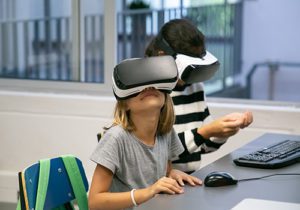
Spread of immersive education models through 5G
5G has the potential to revolutionize the system of education with its increased speed and responsiveness. Technology can pace up the learning process making it more accessible, engaging and appealing. The fantastic speed of the network can bring together the technology of AR and VR for a hands-on AR-specialized digital and VR-enabled immersive learning experience. Teachers can use these technologies to impart knowledge in a better immersive way such as providing virtual school trips around monuments or places of history, that will help the students to retain the information much better. It can transform the educational platforms making it more cost-effective and convenient with better retention of knowledge. This game changer technology will help the students to grasp the topics better and increase their individual grip over subjects, as they can access the same information any number of times. Advances in the 5G technology can also open up new possibilities for students with disabilities. Cloud-based robots can act as full-time assistance to these students with special needs for productive learning. This new mobile technology will transform education beyond classrooms and textbooks with personalized learning, smart classrooms, AR/VR powered classes, and wireless and walled-off classrooms.
Cloud Computing
5G is due to accelerate cloud computing.
The redefining technology of 5G will serve as a catalyst to accelerate cloud computing. The ultra-fast transmission, low-latency, faster connectivity of 5G networks, will forever change the features and functions of cloud applications. With the advent of 5G, Big Data processing technology will overcome its major challenges in speed and connectivity with fast and real-time streaming. For industries that process and analyze massive amounts of sensor data in real-time, 5G networks are expected to reduce the cost of data and analytics, making it more affordable and effective. In edge computing, the technology heavily impacts the performance of mobile and remote devices. The technology will enable remote devices such as location tracking apps, home automation systems, and voice assistants to transfer data ten times faster than the former network. In *AI- and *NLP-based applications, the technology will facilitate optimized network performance, automated management, reduced costs and enhanced efficiency. As 5G technology becomes mainstream, cloud ecosystems will expand the market for potentially productive and profitable applications and services.
Retail
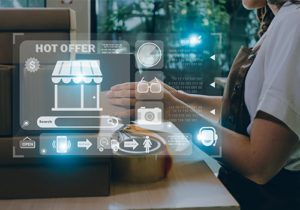
Fashion and choice to be redefined with 5G
The breakthrough technology of 5G will lay the foundation for a brick-and-mortar revolution that will unleash an era of customized and convenient retail. The advancements in the 5G technology has the potential to deliver fast, convenient, and transparent retail services and experiences for customers with uninterrupted business, touchless and contactless checkouts, and integrated in-store and online shopping. The 5G-enabled IoT services have the vast potential to optimize supply chains, improving the product tracking and inventory management capabilities. This next-level data accuracy can minimize the wasted time, empowering retailers with cost-efficiency, agility, and confidence. The technology can redefine the way brands and customers interact, accelerating the AR/VR experiences such as AR/VR enabled shopping, VR dressing rooms, VR based shopping assistance, AR-enabled product management and inventory tracking, AR experience for product information, mobile AR experience in stores and at home, and far more. 5G can boost the big data-generated insights about customers by supporting sensors at the stores and integrating social media and other data, enabling cloud-based analytics in near-real time. These insights could open up the opportunities for mass-customized and relevant services for the customers such as personalized shelf displays, predictive inventory management and real-time integration of data sources. The 5G technology will act as a potential game changer for retailers looking to deliver more value with the frictionless end-to-end customer experience, enhanced mobile broadband and massive machine communications. The 5G digital transformation will enhance the customer experience and nurture long-lasting relationships with the customers.
Gaming
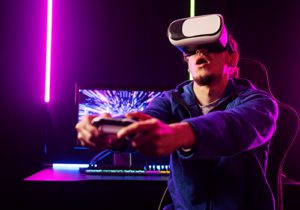
Streaming of complex multiplayer games will become easier with 5G
From edge computing to faster-than-ever responsiveness, 5G solutions could open up a better than ever possibility for the gaming industry. With more than 2.69 Billion players in the world, the technology could save the latency problems that the gamers face. The 5G technology would specially benefit the streaming of complex multiplayer games on the mobile devices. The technology can improve the quality of game streaming and resolve its highly criticized high costs to make them more cost-effective. Paired with edge computing, 5G can realize the potential of AR games with accurate AR experience, enhanced gaming, and improved battery life. Big tech companies have already jumped into the 5G gaming bandwagon, such as Microsoft’s Project xCloud that will stream Xbox games to PCs, consoles, and other mobile devices. Similarly, Google also announced Stadia, which allows the streaming of video games from the Chrome browser. The superfast speed, massive bandwidths, and low-latency of the 5G networks will enable a more collaborative, competitive, affordable, and accessible new era in gaming.
Augmented Reality and Virtual Reality

5G is set to change the landscape of AR/VR sector
5G-enhanced connectivity is predicted to push the AR/VR experiences to its greatest limits. The widespread deployment of 5G networks would accelerate the adoption of AR/VR to wider availability and acceptance. Extreme-throughput, ultra-low latency, and uniform experience will open up the possibility of automotive video streaming, 6 DoF immersive content, event sharing, remote control, and tactile internet. The fast transmission of data will enable high-definition virtual tours, immersive and interactive exposure therapy, anatomical and surgical renderings, live in-person event experience, navigation, and far more. The 5G powered AR/VR applications can change the landscape of AR/VR technologies for the better.
Entertainment and Media

Less buffering, faster content with 5G
With the advent of the 5G networks, your videos are less likely to stall or stop or buffer. The technology is set to disrupt entertainment and media on so many levels with mobile media, mobile advertising, home broadband, and content revolution. Today with more than 70 percent of mobile users watching videos on their internet connected mobile phones, the 5G network will improve this experience like never before. The interactive and immersive technologies of AR and VR will facilitate the movement of enhanced content, closely connecting audiences to the media. On a 5G network, movie downloads will decrease from 7 minutes to 6 seconds, saving an estimated average of 23 hours of loading time per month on browsing social media, gaming, streaming music, and downloading movies and shows. The new world of entertainment charged by the 5G ability, will flourish with shared entertainment, transformed sporting events, accelerated AR/VR experience, redefined audience engagement, and a new generation of super-creators on user-generated platforms.
Military
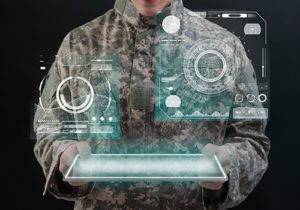
Stronger and faster military responsive with 5G
Military and services are leading the charge on 5G adoption. The game changer technology of 5G-enables real-time data collection and transmission to devices within communication networks. Providing commanders with timely access to actionable intelligence data, for improved operational decision making. The minimized speed in data transmission, also reduces the delay in transferring information in life-threatening situations in the field, giving an edge in battles preventing injuries and death. 5G wireless solutions could enable autonomous military vehicles, Augmented Reality-based navigation, real-time 3D imaging of the battlefields, surveillance, targeting, and far more. The technology also provides solutions for Augmented or Virtual Reality enabled environments to enhance training and execution of military operations. The technology also plays a crucial role in the streamlining of military supply chain upkeeping, enabling better data on material usage and providing a better understanding on resources and spending in budgeting. The armed services now more than ever require the greater potential of the 5G technologies in military applications from improved intelligence and surveillance to logistics and maintenance.
Marketing and Advertising
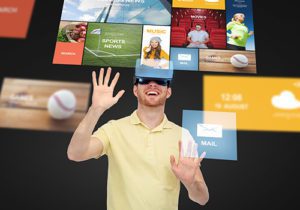
5G to make Marketing and advertisement easy
5G can transform the advertising sphere from slow and unreliable networks to high-quality, interactive and immersive spheres. Opening doors to new models of advertising and personalized marketing enabling moving images and videos in the formats of AR and VR. The reduced load time and buffering will enable a spike in the sphere of video advertising. The technology can connect the wider audiences and bring them closer to the content, making it possible to measure effectiveness in real-time through eye-tracking and biometrics. Communications and media conglomerates across the world are set to explore the new creative formats, pursue strategies for mobile video capabilities and more with the 5G services. According to a research done by Intel, Mobile display advertising is expected to become a 178 Billion market by 2028.
With the rollout of 5G technology, we are heading into a future full of potential, hope and promise. The higher performance and improved efficiency will forever change the way the world connects and communicates.
So buckle up to enjoy broadband-like speeds for the first time, a 5G future isn’t as far as it seems!
*AI – Artificial Intelligence
*NLP – Natural Language Processing
